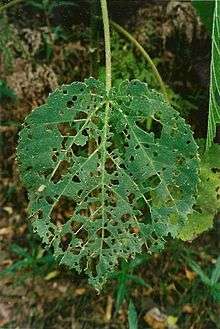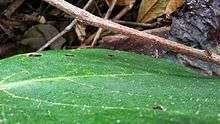Dendrocnide excelsa
Dendrocnide excelsa, also called Australian nettle tree, fibrewood, gimpi gimpi, giant stinging tree, gympie,[1] is a rainforest tree of eastern Australia. It occurs from Tathra, New South Wales to Imbil in southeastern Queensland, and is very common at Dorrigo National Park and other rainforest walks in eastern Australia. The habitat of the giant stinging tree is subtropical, warm temperate or littoral rainforest, particularly in disturbed areas, previously flattened by storms or cyclones.
| Dendrocnide excelsa | |
|---|---|
 | |
| Chewed leaf of a Dendrocnide excelsa at Gumbaynggirr State Conservation Area, west of Nambucca Heads, Australia | |
| Scientific classification | |
| Kingdom: | Plantae |
| Clade: | Tracheophytes |
| Clade: | Angiosperms |
| Clade: | Eudicots |
| Clade: | Rosids |
| Order: | Rosales |
| Family: | Urticaceae |
| Genus: | Dendrocnide |
| Species: | D. excelsa |
| Binomial name | |
| Dendrocnide excelsa | |
Sting
The hairs of the tree exist on all aerial parts, and can cause a severe reaction when in contact with human skin, so it is a hazard to livestock, travelers and campers. Even so, the tree is an important member of the ecosystems of eastern Australian forests. The sting is considered more severe than Dendrocnide photinophylla (shining-leaved stinging tree), but not as severe as Dendrocnide moroides (gympie stinger).

Minor stings can last for an hour or two. However, severe stinging can last for months. First aid for the sting is to apply wax hair-removal strips and then yank them off to remove the hairs.[2] Dendrocnide stings have been known to kill dogs and horses that have brushed against them.[2][3]
Marina Hurley, a leading researcher of stinging trees, found the only way she could handle the plant to study it was with heavy welding gloves.
Description
Dendrocnide excelsa is a medium to large-sized tree with a buttressed base, sometimes over 40 metres tall and in excess of 6 metres wide at the butt.
The trunk can be fluted or flanged. The outer bark is grey and smooth, with minor corky markings. The trunk and buttresses are shaped in even curves. The leaves are alternate and toothed, heart-shaped and very large in positions of shade, exceeding 30 cm in length and a similar width. The sun leaves are smaller. The leaves are replete with stinging hairs, and are eaten by various insects and mammals, such as the chrysomelid beetle.
Flowers appear from November to April, forming in short panicles. The fruit is a purple or blackish nut, maturing from March to August. The flesh is edible, but the danger of stinging hairs precludes human consumption. The fruit is eaten by many rainforest birds, including the regent bowerbird and the green catbird.
Uses
Indigenous Australians used the fibres to make nets and lines.
References
- "Sorting Dendrocnide names". Multilingual Multiscript Plant Name Database. Retrieved 6 April 2014.
- Hurley M (2000) Foliage Attributes and Growth Dynamics of Stinging Trees (Dendrocnide spp.) in northern Australian upland tropical rainforest: implications for herbivores. Australian Journal of Botany, 48:191-201.
- "Dendrocnide". www.bio.davidson.edu. Retrieved 2010-06-11.
- Floyd, A.G., Rainforest Trees of Mainland South-eastern Australia, Inkata Press 1989, ISBN 0-909605-57-2